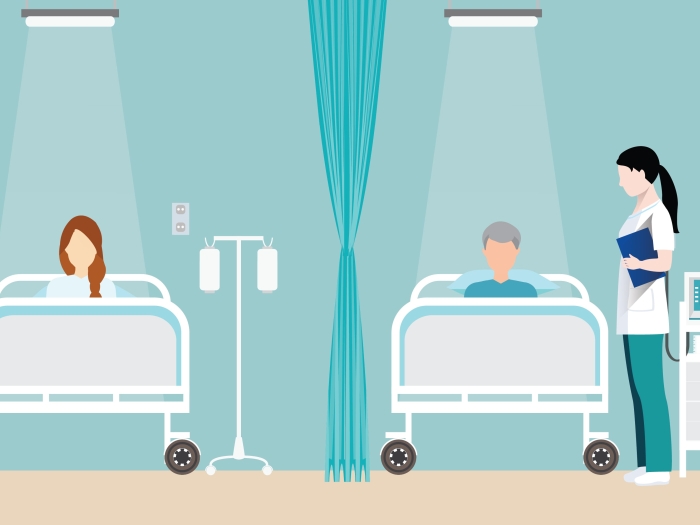Increases in early stenting treatments have paid off in lives and dollars, but some hospitals lag behind, a new study finds. Meanwhile, total costs have grown without reductions in mortality.
4:30 PM
Author |

A new long-term look at heart attack care and spending in America since the turn of the century shows more survival and more spending — but also greater variation in both elements among hospitals.
MORE FROM THE LAB: Sign up for our weekly newsletter
And while some of that added investment (rapid angioplasty to open clogged heart arteries, for example) appears to be paying off, many of the dollars spent in the six months after a heart attack don't seem to reduce long-term death rates.
The findings, published in JAMA Cardiology, were led by members of the University of Michigan Institute for Healthcare Policy and Innovation and the Dartmouth Institute for Health Policy and Clinical Practice. The team analyzed data from nearly 480,000 people covered by traditional Medicare who were treated for acute myocardial infarction at 1,220 hospitals nationwide between 1999 and 2014.
The findings come out one month after the federal government announced the cancellation of a "bundled payment" program that was supposed to incentivize better and more cost-effective care across all settings for the first three months after a heart attack.
Recent government programs to incentivize better heart attack care have focused on capping the payment a hospital or health system can get for the first 30 days of post-heart attack care and publicly reporting how hospitals stack up against others in heart attack deaths.
The U-M study appears to reflect the value of those efforts: In the years since these programs rolled out, 30-day heart attack care spending has stayed flat while mortality has dropped, researchers found.
Lead author Donald Likosky, Ph.D., of U-M's Department of Cardiac Surgery says, "while health care policies have resulted in little variation in 30-day hospital expenditures for heart attacks, they have had little impact on spending beyond 30 days. We see unwarranted variation in spending by hospitals beyond 30 days without much measurable benefit in mortality."
Survival and spending
Overall, the percentage of patients who survive the first six months after a heart attack has increased since 1999 — from 73 percent to 78.5 percent. Americans are more likely to survive the immediate aftermath of a heart attack than people in other developed countries, according to the World Health Organization.
SEE ALSO: Stopped Hearts Need More Cardiac Arrest Research to Start
Spending on the care of heart attack patients has gone up, too — nearly 14 percent during the 15 years of the study, with a plateau in costs in the last six years.
But these across-the-board numbers mask huge variation in both mortality and dollars, depending on the hospital where patients were treated and what kind of care they received.
For instance, Medicare spending rose 44 percent in 15 years for one group of hospitals at the high end of spending growth. But Medicare heart attack spending dropped nearly 19 percent for those at the low end.
Providers are well-intentioned, but many of the current management and treatment strategies are both expensive and don't appear to be effective at reducing mortality.Donald Likosky, Ph.D.
Early PCI: Cost-effective but varying use
Hospitals that focused on getting heart attack patients diagnosed and onto the angioplasty table within the first 24 hours after their first symptoms achieved the biggest gains in survival. As a whole, these hospitals lowered the average cost for a patient's post-heart attack care over six months, the analysis shows.
The percentage of patients getting this procedure done rapidly — called early percutaneous coronary intervention, or PCI — doubled in the time period of the study. And hospitals that increased their use of early PCI the most ended up having lower costs for several types of post-hospital care for their patients, including nursing home and in-home care.
"We also find that patients at high-volume hospitals benefit the most from early stenting treatments by interventional cardiologists," says co-author Jessica Van Parys, Ph.D., of Hunter College. "This finding is most likely because physician and nursing staff learn over time what works best for their heart attack patients."
Not all costs paid off, however. Looking across all hospitals, spending on skilled nursing facility care and home care doubled during the study period, and spending on outpatient care tripled.
But patients who saw doctors in outpatient visits more often after their heart attack were no less likely to die in those first six months, on average.
Going forward
The analysis reveals much opportunity to improve the care that heart attack patients get in the first six months, and the value that the nation gets from the dollars spent on it.
SEE ALSO: How Cardiac ICU Patient Composition Is Changing Over Time
Part of that effort could include providing hospitals and individual providers regular reports on patterns of care that their patients are receiving across all health care settings, as well as the related costs. This would also offer a chance to inform providers and administrators about the evidence behind — or against — certain practices.
"If we don't provide feedback, they won't know where to improve," says Likosky. "We need to develop and implement models for evaluating ways to address both quality and spending. Better involvement of front-line providers in designing and implementing change is crucial, especially if we seek to reduce variability in quality and spending.
"Clinical providers are likely best suited to both know what works and why."
Likosky and colleagues note that in Michigan and northern New England, cardiac care providers and hospitals across their regions have pooled data and fed reports back to each hospital and provider to drive improvement efforts. A similar effort for heart attack care nationwide could start with looking at what differentiates hospitals from one another and what the hospitals with low costs and low mortality can teach their peers.
"Right now, there's no disincentive to use cost-ineffective types of care," says Likosky. "Providers are well-intentioned, but many of the current management and treatment strategies are both expensive and don't appear to be effective at reducing mortality following heart attacks."
In addition to Likosky, the research team includes second author Jessica Van Parys, Ph.D., of Hunter College; Weiping Zhou, M.S., of the Dartmouth Institute for Health Policy and Clinical Practice; William B. Borden, M.D., of the Department of Medicine at George Washington University; Jonathan S. Skinner, Ph.D., of the Dartmouth Institute for Health Policy and Clinical Practice; and Milton C. Weinstein, Ph.D., of Harvard University's T.H. Chan School of Public Health. The research was funded by the National Institutes of Health (AG019783, AG046830) and the Agency for Healthcare Research and Quality (HS-022535).
Reference: JAMA Cardiology, doi:10.1001/jamacardio.2017.4771
Related Editorial: doi:10.1001/jamacardio.2017.4779
Related Editorial: doi:10.1001/jamacardio.2017.4779

Explore a variety of healthcare news & stories by visiting the Health Lab home page for more articles.

Department of Communication at Michigan Medicine
Want top health & research news weekly? Sign up for Health Lab’s newsletters today!





